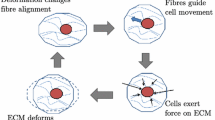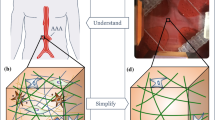Abstract
The mechanics of bio-artificial tissue constructs result from active and passive contributions of cells and extracellular matrix (ECM). We delineated these for a fibroblast-populated matrix (FPM) consisting of chick embryo fibroblast cells in a type I collagen ECM through mechanical testing, mechanical modeling, and selective biochemical elimination of tissue components. From a series of relaxation tests, we found that contributions to overall tissue mechanics from both cells and ECM increase exponentially with the cell concentration. The force responses in these relaxation tests exhibited a logarithmic decay over the 3600 second test duration. The amplitudes of these responses were nearly linear with the amplitude of the applied stretch. The active component of cellular forces rose dramatically for FPMs containing higher cell concentrations.










Similar content being viewed by others
REFERENCES
Bell, E., B. Ivarsson, and C. Merrill. Production of a tissue-like structure by contraction of collagen lattices by human fibroblasts of different proliferative potential in vitro. Proc. Natl. Acad. Sci. USA 76(3):1274–1278, 1979.
Bellows, C. G., A. H. Melcher, and J. E. Aubin. Cells of different types compress and remodel collagen to markedly different degrees. J. Cell Sci. 50:299–314, 1981.
Cummings, C. L., D. Gawlitta, R. M. Nerem, and J. P. Stegemann. Properties of engineered vascular constructs made from collagen, fibrin, and collagen-fibrin mixtures. Biomaterials 25(17):3699–3706, 2004.
Desmouliere, A., C. Chaponnier, and G. Gabbiani. Tissue repair, contraction, and the myofibroblast. Wound Repair. Regen. 13(1):7–12, 2005
Eshelby, J. D. The determination of the elastic field outside an ellipsoidal inclusion and related problems. Proc. Roy. Soc. A 241, 1957.
Fung, Y. C. Biomechanics: Mechanical Properties of Living Tissues. New York: Springer, 1993, 277–280.
Gabbiani, G. I. The myofibroblast in wound healing and fibrocontractive disease. J. Pathol. 200(4):500–503, 2003.
Hill, R. The Mathematical Theory of Plasticity. London, UK: Oxford University Press, 1950.
Knapp, D. M., T. T. Tower, R. T. Tranquillo, and V. H. Barocas. Estimation of cell traction and migration in an isometric cell traction assay. AIChE J. 45(12):2628–2640, 1999.
Kolodney, M. S., and R. B. Wysolmerski. Isometric contraction by fibroblasts and endothelial cells in tissue culture: A quantitative study. J. Cell Biol. 117:73–82, 1992.
Marquez, J. P., G. M. Genin, G. I. Zahalak, and E. L. Elson. Thin bio-artificial tissues in plane stress: The relationship between cell and tissue strain, and an improved constitutive model. Biophys. J. 88:765–777, 2005.
Marquez, J. P., G. M. Genin, G. I. Zahalak, and E. L. Elson. The relationship between cell and tissue strain in three-dimensional bio-artificial tissues. Biophys. J. 88:778–789, 2005.
Pryse, K. M., A. Nekouzadeh, G. M. Genin, E. L. Elson, G. I. Zahalak. Incremental mechanics of collagen gels: New experiments and a new viscoelastic model. Ann. Biomed. Eng. 31(10):1287–1296, 2003.
Pryse, K. M., and E. L. Elson. Mechanical effects of deoxycholate, triton, cytochalasin, and latrunculin A, on reconstituted collagen and fibroblast cells. Manuscript in preparation, 2005.
Roberts, A. P., and E. J. Garboczi. Elastic properties of model porous ceramics. J. Am. Cer. Soc. 83(12):3041–3048, 2000.
Shreiber, D. I., V. H. Barocas, and R. T. Tranquillo. Temporal variations in cell migration and traction during fibroblast-mediated gel compaction. Biophys. J. 84(6):4102–4114, 2003.
Tomasek, J. J., G. Gabbiani, B. Hinz, C. Chaponnier, and R. A. Brown. Myofibroblasts and mechano-regulation of connective tissue remodelling. Nat. Rev. Mol. Cell Biol. 3(5):349–363, 2002.
Thomopoulos, S., G. M. Fomovsky, and J. W. Holmes. The development of structural and mechanical anisotropy in fibroblast populated collagen gels. ASME J. Biomech. Eng. 127:742–750, 2005.
Tranquillo, R. T., and J. D. Murray. Continuum model of fibroblast-driven wound contraction: Inflammation-mediation. J. Theor. Biol. 158:135–172, 1992.
Wakatsuki, T., M. S. Kolodney, G. I. Zahalak, and E. L. Elson. Cell mechanics studied by a reconstituted model tissue. Biophys. J. 79:2353–2368, 2000.
Wang, J. H. C., P. Goldschmidt-Clermont, and F. C. Yin. Contractility affects stress fiber remodeling and reorientation of endothelial cells subjected to cyclic mechanical stretching. Ann. Biomed. Eng. 28:1165–1171, 2000.
Wille, J. J., C. M. Ambrosi, and F. C. Yin. Comparison of the effects of cyclic stretching and compression on endothelial cell morphological responses. J. Biomech. Eng. 126(5):545–551, 2004.
Wille, J. J., E. L. Elson, and R. J. Okamoto. Cell and matrix mechanics determined by cyclic stretch of bioartificial tissues. Proceedings of the Society for Experimental Mechanics Annual Conference and Exposition, June 4–7, 2006, St. Louis, MO. Paper number 182.
Zahalak, G. I., J. E. Wagenseil, T. Wakatsuki, and E. L. Elson. A cell-based constitutive relation for bio-artificial tissues. Biophys. J. 79:2369–2381, 2000.
ACKNOWLEDGMENTS
This work was supported in part by the National Institutes of Health through grants AR47591 and GM38838. The authors thank Tetsuro Wakatsuki for many insightful discussions.
Author information
Authors and Affiliations
Corresponding author
Additional information
An erratum to this article can be found at http://dx.doi.org/10.1007/s10439-006-9215-4
Rights and permissions
About this article
Cite this article
Marquez, J.P., Genin, G.M., Pryse, K.M. et al. Cellular and Matrix Contributions to Tissue Construct Stiffness Increase with Cellular Concentration. Ann Biomed Eng 34, 1475–1482 (2006). https://doi.org/10.1007/s10439-006-9160-2
Received:
Accepted:
Published:
Issue Date:
DOI: https://doi.org/10.1007/s10439-006-9160-2




